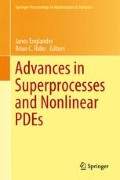Abstract
In several examples, dualities for interacting diffusion and particle systems permit the study of the longtime behavior of solutions. A particularly difficult model in which many techniques collapse is a two-type model with mutually catalytic interaction introduced by Dawson/Perkins for which they proved under some assumptions a dichotomy between extinction and coexistence directly from the defining equations.In the present chapter we show how to prove a precise dichotomy for a related model with negatively correlated noises. The proof uses moment bounds on exit times of correlated Brownian motions from the first quadrant and explicit second moment calculations. Since the uniform integrability bound is independent of the branching rate our proof can be extended to infinite branching rate processes.
Mathematics Subject Classification (2000): Primary 60J80; Secondary 60J85.
LM is partly supported by the Israel Science Foundation and B. and G. Greenberg Research Fund (Ottawa)
LD was supported by the Fondation Science Matématiques de Paris
Access this chapter
Tax calculation will be finalised at checkout
Purchases are for personal use only
References
J. Blath, L. Döring, A. Etheridge “On the Moments and the Wavespeed of the Symbiotic Branching Model.” The Annals of Probability, 2011, Vol. 39, No. 1, pp. 252–290.
D. L. Burkholder. Exit times of Brownian motion, harmonic majorization, and Hardy spaces. Advances in Math., 26(2):182–205, 1977.
J.T. Cox, D. Dawson, A. Greven “Mutually Catalytic Super branching Random Walks: Large Finite Systems and Renormalization Analysis.” AMS Memoirs, 2004, Vol. 171.
J.T. Cox, A. Klenke “Recurrence and Ergodicity of Interacting Particle Systems.” Probab. Theory Relat. Fields, 2000, Vol. 116, pp. 239–255.
D. Dawson, K. Fleischmann “Critical dimension for a model of branching in a random medium.” Z. Wahrsch. Verw. Gebiete, 70(3), pp. 315–334, 1985.
L. Döring, L. Mytnik “Mutually Catalytic Branching Processes on the lattice and Voter Processes with Strength of Opinion.” arXiv:1109.6106v1.
D. Dawson, E. Perkins “Long-Time Behavior and Coexistence in a Mutually Catalytic branching model.” The Annals of Probability, 1998, Vol. 26, No.3. pp. 1088–1138.
A. Etheridge “An Introduction to Superprocesses.” University Lecture Series, Amer. Math. Soc., 2000.
A. Etheridge, K. Fleischmann “Compact interface property for symbiotic branching.” Stochastic Processes and their Applications, 2004, Vol. 114, pp. 127–160.
A. Greven, F. den Hollander “Phase transitions for the longtime behavior of interacting diffusions.” The Annals of Probability, 2007, Vol. 35, No.4., pp. 1250–1306.
A. Jakubowski “A non-Skorohod topology on the Skorohod space.” Electronic Journal of Probability, 1997, Vol. 2, No.4., pp. 1–21.
A. Klenke, L. Mytnik “Infinite Rate Mutually Catalytic Branching in Infinitely Many Colonies: The Longtime Behaviour.” to appear in Annals of Probability.
A. Klenke, L. Mytnik “Infinite Rate Mutually Catalytic Branching in Infinitely Many Colonies: Construction, Characterization and Convergence.” to appear in Probab. Theory Relat. Fields.
A. Klenke, M. Oeler “A Trotter Type Approach to Infinite Rate Mutually Catalytic Branching.” The Annals of Probability, 2010, Vol. 38, 479–497.
T. Liggett “Interacting Particle Systems.” Reprint of the 1985 original. Classics in Mathematics. Springer-Verlag, Berlin, 2005.
P.A. Meyer, W.A. Zheng “Tightness criteria for laws of semimartingales.” Ann. Inst. H. Poincaré Probab. Statist. 20 (1984), no. 4, 353–372.
T. Shiga “Ergodic Theorems and Exponential Decay of Sample Paths for Certain Interacting Diffusion Systems.” Osaka J. Math., 1992, Vol. 29, p. 789–807.
T. Shiga, A. Shimizu “Infinite dimensional stochastic differential equations and their applications.” J. Math. Kyoto Univ., 1980, Vol. 20, No.3., pp. 395–416.
F. Spitzer ”Some theorems concerning 2-dimensional Brownian motion.” Trans. Amer. Math. Soc., 1958, No. 87, pp. 187–197.
Acknowledgements
The authors thank an anonymous referee for a very careful reading of the manuscript.
Author information
Authors and Affiliations
Corresponding author
Editor information
Editors and Affiliations
Rights and permissions
Copyright information
© 2013 Springer Science+Business Media New York
About this paper
Cite this paper
Döring, L., Mytnik, L. (2013). Longtime Behavior for Mutually Catalytic Branching with Negative Correlations. In: Englander, J., Rider, B. (eds) Advances in Superprocesses and Nonlinear PDEs. Springer Proceedings in Mathematics & Statistics, vol 38. Springer, Boston, MA. https://doi.org/10.1007/978-1-4614-6240-8_6
Download citation
DOI: https://doi.org/10.1007/978-1-4614-6240-8_6
Published:
Publisher Name: Springer, Boston, MA
Print ISBN: 978-1-4614-6239-2
Online ISBN: 978-1-4614-6240-8
eBook Packages: Mathematics and StatisticsMathematics and Statistics (R0)

